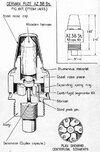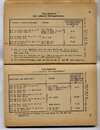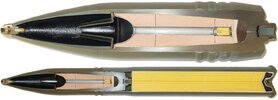The first one this year 
Cutaway model of an 8,8cm Gr.39 HL. (shaped charge shell 39) for the KwK.43 gun in the Koningstiger, the Jagdpanther and the Pak 43
The weight of projectile is 7,65 kg. The nose fuze used is the AZ38St (direct action 38 steel). The shell is of the PIBD (Point Ignited Base Detonated) type. This means that if the duplex detonator of the fuze is ignited by the firing pin upon impact, the flame of the explosion is led down through the hollow aluminium tube placed in the explosive charge, igniting the heat sensitive detonator in the booster. The detonation wave will now move from bottom upward. When the explosion wave reaches the cone, the Monroe effect will occur, thereby piercing through 90 mm steel. As the projectile is not depending upon speed to penetrate armour it does not matter if the target is at 100 meters or 3000 meters from the gun firing the projectile to obtain 90mm penetration.
Functioning of the AZ38St: After firing, the centrifugal safety weights are thrown outward, overriding the force of the surrounding expanding spring ring. The firing pin is now free to move down into the duplex detonator cap if a target is hit.
The entire explosive charge is made of Pentrite, devided in three stacked blocks, wrapped in a cartboard container. Under the container a 5 mm layer of magnesiumkit (white) is cast, a kind of WW2 polyester resign. Under the magnesiumkit layer a sphere shaped filler piece made out of either bakelite or glass is placed. The straight walled cone pointing forward and placed in the nose cone is a protective cone ,preventing shrappnel from the duplex detonator damaging the shaped charge cone.
The shellcase 6388St is steel made, brass plated and filled with 1,68 kg Digl. R.P –G 0,5- 700/650 – 7/6 powder charge, meaning 1,68 kg Diglykol RohrPulver (Diglycol Powder Sticks) type G 0,5 , lengths 700mm (core) and 650mm (side and below tracer element), 7 mm in diameter with a hole of 6 mm through. A bag of 40 grams Nz.Man. N.P 1,5x1,5 rifle powder is sewed to the base of the powderbag housing the sticks to instantaniously ignite the main charge.
Length of the Pzgr.39 HL : 1170mm
Length of projectile (with tracer): 446 mm
Length of shellcase : 822mm
V0 : 600 mtrs/sec
Regards, DJH
Cutaway model of an 8,8cm Gr.39 HL. (shaped charge shell 39) for the KwK.43 gun in the Koningstiger, the Jagdpanther and the Pak 43
The weight of projectile is 7,65 kg. The nose fuze used is the AZ38St (direct action 38 steel). The shell is of the PIBD (Point Ignited Base Detonated) type. This means that if the duplex detonator of the fuze is ignited by the firing pin upon impact, the flame of the explosion is led down through the hollow aluminium tube placed in the explosive charge, igniting the heat sensitive detonator in the booster. The detonation wave will now move from bottom upward. When the explosion wave reaches the cone, the Monroe effect will occur, thereby piercing through 90 mm steel. As the projectile is not depending upon speed to penetrate armour it does not matter if the target is at 100 meters or 3000 meters from the gun firing the projectile to obtain 90mm penetration.
Functioning of the AZ38St: After firing, the centrifugal safety weights are thrown outward, overriding the force of the surrounding expanding spring ring. The firing pin is now free to move down into the duplex detonator cap if a target is hit.
The entire explosive charge is made of Pentrite, devided in three stacked blocks, wrapped in a cartboard container. Under the container a 5 mm layer of magnesiumkit (white) is cast, a kind of WW2 polyester resign. Under the magnesiumkit layer a sphere shaped filler piece made out of either bakelite or glass is placed. The straight walled cone pointing forward and placed in the nose cone is a protective cone ,preventing shrappnel from the duplex detonator damaging the shaped charge cone.
The shellcase 6388St is steel made, brass plated and filled with 1,68 kg Digl. R.P –G 0,5- 700/650 – 7/6 powder charge, meaning 1,68 kg Diglykol RohrPulver (Diglycol Powder Sticks) type G 0,5 , lengths 700mm (core) and 650mm (side and below tracer element), 7 mm in diameter with a hole of 6 mm through. A bag of 40 grams Nz.Man. N.P 1,5x1,5 rifle powder is sewed to the base of the powderbag housing the sticks to instantaniously ignite the main charge.
Length of the Pzgr.39 HL : 1170mm
Length of projectile (with tracer): 446 mm
Length of shellcase : 822mm
V0 : 600 mtrs/sec
Regards, DJH






